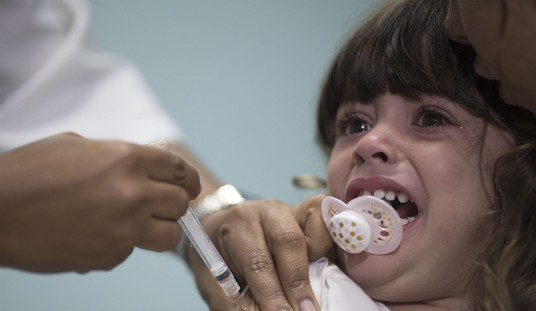Our president reassured west Africans last month that they needn’t fear riding the bus since you can’t get Ebola from sitting next to someone who’s infected. Now the head of the CDC’s telling the country that he’ll see to it that people who might be infected stay the hell off of mass transportation for a few weeks. Hello?
https://twitter.com/NoahCRothman/status/522432578176188417
I’m seeing a lot of reactions like this on Twitter this afternoon, which is bad, bad news for the White House:
Americans exposed to Ebola shouldn't fly, but West Africans? Only a paranoid hysteric would subject THEM to such restrictions.
— John Hayward (@Doc_0) October 15, 2014
It was not irrational for Duncan to prize his life above those of foreign strangers, and it's not irrational for us to do so, either.
— Ursus, Director of Weather and Banana Programming (@AceofSpadesHQ) October 15, 2014
The administration’s counter, I assume, will be that there’s a difference between a targeted ban on flying aimed at people whom we know for a fact have been exposed to Ebola and a blanket ban on all west Africans because some of them might hypothetically have been exposed. (The whole point of screening passengers for fevers as they board flights in Africa is to impose a more targeted ban.) Think voters will be comforted by that, though? Support for banning air travel from Ebola countries is sky high; the more the disease spreads there, the more intense that support will become here. Although there are no direct flights from affected nations to the U.S., political pressure will mount on European hubs to restrict travel from Africa. I don’t understand the argument either that a travel ban would make the virus spread more quickly in Africa. Supposedly that’s because aid workers will have trouble getting in and out of Liberia et al., but as Megyn Kelly argued last night, you could have chartered flights. Failing that, you could make three weeks of quarantine a condition for those workers. They’re already willing to put their lives on the line by traveling to the eye of the Ebola storm to help people. Presumably they’d tolerate a few weeks of isolation together when they’re done, either on site or after they’ve returned, to eliminate the risk of infection back home.
Something else I don’t understand: How did 16 people from Doctors Without Borders get infected, nine of them fatally? Politico had a nice explainer last night about how diligent outfits like DWB and Samaritan’s Purse are in training their staffers to put on and remove their protective clothing. They drill on it; they use a buddy system. They’re well prepared. And yet — nine deaths. Kent Brantly and Nancy Writebol, the two Americans from Samaritan’s Purse who contracted Ebola and survived after coming home, still don’t know how they got the disease. Now we’ve got not one but two of the nurses who treated Thomas Duncan sick with it. How does that happen? According to the CDC, merely touching an Ebola patient shouldn’t be enough to infect you; the fluids of a person carrying the virus need to enter your body through broken skin or through the mucus membranes of a body cavity like the eyes, nose, or mouth. I can understand how two nurses who might not have been properly equipped and had no experience might slip up but I have a hard time understanding how 16 different people from the highly disciplined Doctors Without Borders made careless errors to get fluids in their mouths or eyes. Maybe it’s a pure numbers game — if DWB is treating thousands of people with the disease, there are inevitably going to be a dozen or so catastrophic mistakes — but the more supposedly “protected” health-care workers come down with the disease, the more the public will start to suspect that the virus spreads more easily than the CDC thinks.
On the other hand, if it spreads more easily than thought, how is it that Thomas Duncan’s immediate family are all fine despite hugging and kissing him while he was sick and sharing a toilet and dinner table with him for days? The answer, most likely, is that he wasn’t highly contagious until he was hospitalized. The viral load builds and builds as the patient nears death; his family may have lucked out in the sense that they caught him in the earliest stages whereas those two poor nurses dealt with him when he was overwhelmed by it. Anyway, here’s the guy from the CDC whom nobody believes anymore. News is breaking as I write this that the second nurse was actually mildly symptomatic with a low fever when she flew on Monday(!). If it’s true that Duncan wasn’t contagious in his first stages, that bodes well for people who were on the plane with the nurse.
Update: I don’t know what to tell you here, guys. Duncan was in isolation for two days — and yet the staff wasn’t wearing protective clothing? What?
Health care workers treating Thomas Eric Duncan in a hospital isolation unit didn’t wear protective hazardous-material suits for two days until tests confirmed the Liberian man had Ebola — a delay that potentially exposed perhaps dozens of hospital workers to the virus, according to medical records.
The 3-day window of Sept. 28-30 is now being targeted by investigators for the Centers for Disease Control and Prevention as the key time during which health care workers may have been exposed to the deadly virus by Duncan, who died Oct. 8 from the disease.
Duncan was suspected of having Ebola when he was admitted to a hospital isolation unit Sept. 28, and he developed projectile vomiting and explosive diarrhea later that day, according to medical records his family turned over to The Associated Press.
So, new theory: Duncan wasn’t highly contagious until the evening of the 29th or morning of the 30th, by which time he was away from his family but in direct contact with hospital staff. That’s why no one in the family is sick but two nurses, both of whom presumably treated him on the 29th or 30th, came down with it. If that’s how it went down, expect the CDC to cite this as evidence of how relatively difficult it is to get Ebola. Even with Duncan erupting with fluids, “only” two people got sick. So far as we know right now.
Update: I changed the headline from “protective clothes” to “hazmat clothes” because a Twitter pal thinks there’s a distinction. It’s not that the nurses didn’t wear face shields, smocks, etc, while treating Duncan, he thinks, it’s that they didn’t wear full moon suits. The story says “workers at Texas Health Presbyterian Hospital Dallas did not abandon their gowns and scrubs for hazmat suits” until the 30th, which is ambiguous. It would make sense, though, that they wouldn’t enter an isolation zone without at least the protective clothing that the CDC prescribes. Which brings us back to the question: How did the two nurses get the disease if they were in fact wearing protective clothing?
Update: This can’t be true, can it? The CDC is waiting for passengers on the second nurse’s flight to contact them?
RT @CDCgov: CDC is asking all 132 passengers on Frontier Airlines flight 1143 from CLE to DFW on 10/13 to call 1-800-CDC-INFO
— Zeke Miller (@ZekeJMiller) October 15, 2014
https://twitter.com/seanmdav/status/522463282964475905








Join the conversation as a VIP Member